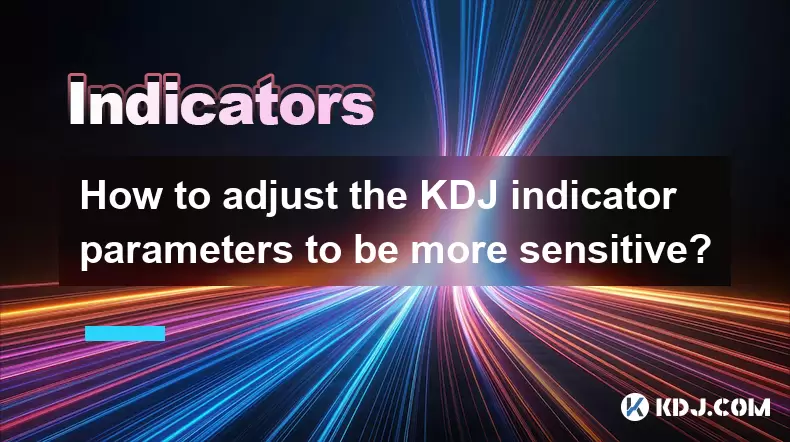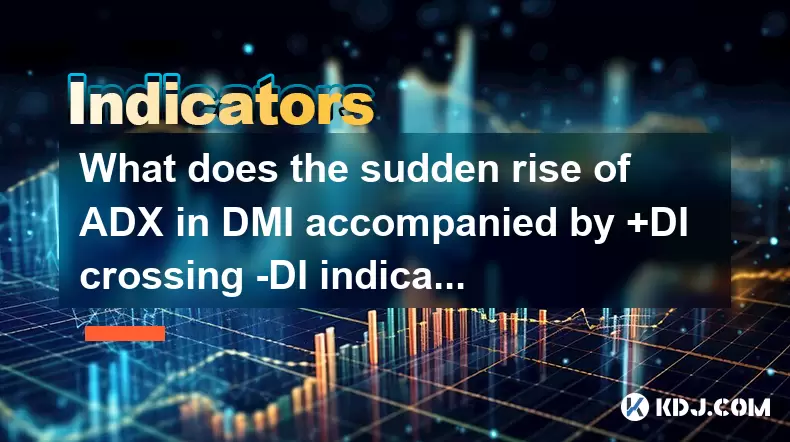-
 Bitcoin
Bitcoin $117600
1.78% -
 Ethereum
Ethereum $3742
4.20% -
 XRP
XRP $3.145
2.58% -
 Tether USDt
Tether USDt $1.000
0.03% -
 BNB
BNB $783.7
3.64% -
 Solana
Solana $186.2
4.95% -
 USDC
USDC $1.000
0.04% -
 Dogecoin
Dogecoin $0.2366
5.41% -
 TRON
TRON $0.3180
1.96% -
 Cardano
Cardano $0.8248
4.11% -
 Hyperliquid
Hyperliquid $44.33
7.38% -
 Sui
Sui $3.978
9.94% -
 Stellar
Stellar $0.4381
5.56% -
 Chainlink
Chainlink $18.34
5.20% -
 Hedera
Hedera $0.2650
12.59% -
 Bitcoin Cash
Bitcoin Cash $554.8
6.94% -
 Avalanche
Avalanche $24.07
4.41% -
 Litecoin
Litecoin $113.1
3.56% -
 Toncoin
Toncoin $3.369
10.08% -
 UNUS SED LEO
UNUS SED LEO $8.990
0.00% -
 Shiba Inu
Shiba Inu $0.00001403
6.04% -
 Ethena USDe
Ethena USDe $1.001
0.02% -
 Uniswap
Uniswap $10.52
6.80% -
 Polkadot
Polkadot $4.124
5.40% -
 Monero
Monero $324.5
-1.06% -
 Dai
Dai $1.000
0.02% -
 Bitget Token
Bitget Token $4.584
1.79% -
 Pepe
Pepe $0.00001257
5.70% -
 Aave
Aave $298.2
5.29% -
 Cronos
Cronos $0.1330
6.22%
如何将KDJ指示参数调整更灵敏?
调整KDJ指标的%k,%d和平滑期,以提高加密交易中更快的市场趋势检测的敏感性。
2025/06/11 18:28

KDJ指标简介
KDJ指标(也称为随机振荡器)是加密货币市场中的交易者使用的一种流行的技术分析工具,可确定潜在的趋势逆转和过度购买或过分售出条件。 KDJ指标由三行组成: K , D和J。 K线代表最快的线,对价格变化最敏感,D线是K线的移动平均线,J线是从K和D线派生的,通常用于生成交易信号。调整KDJ指标的参数可以帮助交易者使其对价格变动更加敏感,从而有可能更快地发现市场变化。
了解KDJ指标参数
KDJ指标使用三个主要参数: %k期, %d期和平滑期。 %k期确定用于计算%k线的周期数, %d期为计算%d线的时期数,通常是%k线的移动平均值,并且平滑周期用于在计算%d线之前平滑%k线。默认情况下,这些参数通常设置为9 for%k,3 for%d,平滑期为3。调整这些参数可以使指标对价格变化更加敏感。
调整%k期以提高灵敏度
为了使KDJ指标更加敏感,您可以从调整%k期开始。较短的%k期会使K线对价格变化的反应更快,这可能有益于识别短期趋势和潜在的逆转。这是您可以调整%k期的方法:
- 打开您的交易平台或图表软件。
- 找到KDJ指示器设置或参数。
- 找到%k周期设置,并将其从9默认值减少到较低的数字,例如5或3。
- 保存更改并观察K线对价格变动的反应。
较短的%k期会导致K线波动更快,这可以帮助您更快地检测市场情绪的变化。但是,请注意,较短的%k期也可能导致更多的错误信号,因此必须平衡灵敏度和可靠性。
调整%d时期以提高灵敏度
%d期是可以调整的另一个参数,以提高KDJ指标的灵敏度。 %d线是%k线的移动平均线,较短的%d期会使%d线对%k线的变化更快地反应。您可以调整%D期:
- 打开您的交易平台或图表软件。
- 找到KDJ指示器设置或参数。
- 找到%d期间设置,并将其从默认值3减少到较低的数字,例如2或1。
- 保存更改并观察%d线对%k线的变化的反应。
较短的%d期会导致%d线对%k系更敏感,这可以帮助您更快地识别潜在的交易信号。但是,像%k期一样,较短的%d期也可能会增加虚假信号的可能性,因此找到正确的平衡至关重要。
调整平滑周期以提高灵敏度
平滑周期是可以调整的最终参数,以增加KDJ指示器的灵敏度。平滑周期用于在计算%d线之前平滑%k线,较短的平滑周期将导致平滑较低,从而使%k线对价格变化的响应更快。这是您可以调整平滑期的方法:
- 打开您的交易平台或图表软件。
- 找到KDJ指示器设置或参数。
- 找到平滑周期设置,并将其从默认值3减少到较低的数字,例如2或1。
- 保存更改并观察%K线对价格变动的反应。
较短的平滑期会导致%K线的平滑度较低,这可以帮助您更快地检测市场情绪的变化。但是,像其他参数一样,较短的平滑周期也可能会增加错误信号的可能性,因此找到正确的平衡很重要。
结合参数调整以达到最佳灵敏度
为了实现KDJ指标的最佳灵敏度,您可以将调整对%k期, %d期和平滑期结合起来。这是如何结合这些调整的一个示例:
- 打开您的交易平台或图表软件。
- 找到KDJ指示器设置或参数。
- 将%k期从9降低到5。
- 将%d期从3降低到2。
- 将平滑周期从3减少到2。
- 保存更改并观察KDJ指标对价格变动的反应。
通过结合这些调整,您可以使KDJ指标对价格变化更加敏感,从而可以更快地发现市场趋势和逆转。但是,必须测试参数的不同组合,以找到用于交易策略的最佳设置以及您正在交易的特定加密货币。
监视和微调调整后的KDJ指示器
调整KDJ指示器参数后,监视其性能并根据需要微调设置至关重要。您可以采取一些步骤来监视和调整调整后的KDJ指标:
- 观察指标的性能:密切关注调整后的KDJ指标对价格变动的反应以及它是否生成可靠的交易信号。
- 与历史数据进行比较:使用历史价格数据来测试调整后的KDJ指标,并评估其在不同市场条件上的性能。
- 逐步调整参数:如果调整后的KDJ指示器过于敏感并生成过多的错误信号,则可以逐步增加%k期,%d期或平滑期以降低灵敏度。
- 测试不同的参数组合:使用%K期,%D期和平滑期的不同组合进行实验,以找到您的交易策略的最佳设置。
通过不断监视和调整调整后的KDJ指标,您可以确保它在确定加密货币市场的潜在交易机会方面保持有效和可靠。
常见问题
问:调整KDJ指标参数可以影响其可靠性吗?
答:是的,调整KDJ指标参数以使其更敏感可能会影响其可靠性。更敏感的指标可能会产生更多的错误信号,因此必须在灵敏度和可靠性之间找到适当的平衡。
问:是否还有其他技术指标可以与调整后的KDJ指标一起使用?
答:是的,您可以使用其他技术指标,例如相对强度指数(RSI)或移动平均收敛差异(MACD),并与调整后的KDJ指标一起确认交易信号并提高交易策略的整体可靠性。
问:我应该多久审查和调整KDJ指标参数?
答:这是一种很好的做法,可以定期审查和调整KDJ指标参数,尤其是当市场条件变化或切换到交易其他加密货币时。您可能需要在挥发性市场条件下更频繁地调整参数,并且在稳定的市场条件下较低的频率。
问:调整后的KDJ指标可以用于长期交易策略吗?
答:虽然调整后的KDJ指标通常用于短期交易策略,但由于其灵敏度的提高,它也可以通过调整参数较低敏感并与其他长期指标结合使用,用于长期交易策略。
免责声明:info@kdj.com
所提供的信息并非交易建议。根据本文提供的信息进行的任何投资,kdj.com不承担任何责任。加密货币具有高波动性,强烈建议您深入研究后,谨慎投资!
如您认为本网站上使用的内容侵犯了您的版权,请立即联系我们(info@kdj.com),我们将及时删除。
- Lasmeta,Pyth网络,Novadrop NFTS:解码嗡嗡声
- 2025-07-26 16:30:12
- Tokenomics:如何建立加密项目以获得长期成功,《纽约人指南》
- 2025-07-26 16:30:12
- 华尔街的比特币大富翁:ETF文件信号Crypto的即将派对
- 2025-07-26 15:10:12
- 比特币,辛西娅·卢米斯(Cynthia Lummis)和自由金钱:纽约的观点
- 2025-07-26 15:10:12
- 英国技术,比特币和投资:解码最新趋势
- 2025-07-26 15:30:11
- 英国加密法规:比特币会为散户投资者开放吗?
- 2025-07-26 15:30:11
相关百科

这意味着在第一次以短位置安排移动平均线后,篮板被阻塞?
2025-07-26 10:51:10
了解短期移动平均配置当交易者在移动平均值中提到“短职位安排”时,他们描述了一种技术设置,其中较短的移动平均值低于长期的交叉。这种配置通常标志着看跌趋势。例如,当5周期移动平均线(MA)在10个周期MA以下和10个周期的MA以下时,已经以下是20个周期的MA时,据说移动平均值是按降序对齐的。这种对齐通...

当价格连续五天沿5天移动平均线上涨时,这意味着什么?
2025-07-26 08:07:37
了解加密货币交易中的5天移动平均值5天移动平均线(5DMA)是加密货币交易中广泛使用的技术指标,该指标计算过去五天资产的平均收盘价。贸易商使用此指标来平滑短期价格波动并确定基本趋势。当价格连续五天沿5天移动平均线上升时,这表明市场上的势头持续一致。这种模式表明,每天的收盘价不仅高于前一天的收盘价,而...

当价格突破了60天的移动平均水平,但第二天收缩是什么意思?
2025-07-26 06:01:03
了解加密货币交易中的60天移动平均60天的移动平均线(60DMA)是加密货币市场中广泛使用的技术指标,在过去60个交易日内平滑了价格数据。它通过滤除短期价格波动来帮助交易者确定整体趋势方向。当目前的价格高于60dma时,它通常标志着看涨的趋势,而低于下方的价格表明看跌势头。交易者会关注跨界车(当价格...

DMI中ADX突然崛起伴随 +di Crossing -di表示?
2025-07-26 13:21:19
了解DMI及其核心组件定向运动指数(DMI)是一种技术分析工具,用于确定加密货币价格移动的趋势的存在和强度。它由三个关键组成部分组成:平均方向指数(ADX) ,正方向指标(+di)和负方向指示器(-DI) 。 ADX无论方向如何衡量趋势的强度,而 +di和-di分别反映了上下价格动量。在分析Bitc...

当Obv继续达到新高点但价格停滞时,这意味着什么?
2025-07-26 09:57:50
了解体积体积(明显)指标平衡量(OBP)是技术分析指标,该指标使用量流量来预测库存或加密货币价格的变化。由乔·格兰维尔(Joe Granville)开发的Obv在一个简单的前提下运行:数量先于价格变动。计算很简单 - 与上一时期相比,加密货币的收盘价上涨时,该期间的体积添加到累积的OBP中。相反,如...

EMA12和EMA26的黄金十字架是什么反映的?
2025-07-26 06:44:03
了解EMA12和EMA26中的黄金十字金十字是加密货币市场中广泛认可的技术指标,表明潜在的看涨逆转。当12个周期指数的移动平均值(EMA12)交叉以上26个周期指数移动平均值(EMA26)时,就会发生这种情况。这种模式通常被解释为短期势头超越长期动力的标志,表明买家正在获得控制。交易者使用此信号预测...

这意味着在第一次以短位置安排移动平均线后,篮板被阻塞?
2025-07-26 10:51:10
了解短期移动平均配置当交易者在移动平均值中提到“短职位安排”时,他们描述了一种技术设置,其中较短的移动平均值低于长期的交叉。这种配置通常标志着看跌趋势。例如,当5周期移动平均线(MA)在10个周期MA以下和10个周期的MA以下时,已经以下是20个周期的MA时,据说移动平均值是按降序对齐的。这种对齐通...

当价格连续五天沿5天移动平均线上涨时,这意味着什么?
2025-07-26 08:07:37
了解加密货币交易中的5天移动平均值5天移动平均线(5DMA)是加密货币交易中广泛使用的技术指标,该指标计算过去五天资产的平均收盘价。贸易商使用此指标来平滑短期价格波动并确定基本趋势。当价格连续五天沿5天移动平均线上升时,这表明市场上的势头持续一致。这种模式表明,每天的收盘价不仅高于前一天的收盘价,而...

当价格突破了60天的移动平均水平,但第二天收缩是什么意思?
2025-07-26 06:01:03
了解加密货币交易中的60天移动平均60天的移动平均线(60DMA)是加密货币市场中广泛使用的技术指标,在过去60个交易日内平滑了价格数据。它通过滤除短期价格波动来帮助交易者确定整体趋势方向。当目前的价格高于60dma时,它通常标志着看涨的趋势,而低于下方的价格表明看跌势头。交易者会关注跨界车(当价格...

DMI中ADX突然崛起伴随 +di Crossing -di表示?
2025-07-26 13:21:19
了解DMI及其核心组件定向运动指数(DMI)是一种技术分析工具,用于确定加密货币价格移动的趋势的存在和强度。它由三个关键组成部分组成:平均方向指数(ADX) ,正方向指标(+di)和负方向指示器(-DI) 。 ADX无论方向如何衡量趋势的强度,而 +di和-di分别反映了上下价格动量。在分析Bitc...

当Obv继续达到新高点但价格停滞时,这意味着什么?
2025-07-26 09:57:50
了解体积体积(明显)指标平衡量(OBP)是技术分析指标,该指标使用量流量来预测库存或加密货币价格的变化。由乔·格兰维尔(Joe Granville)开发的Obv在一个简单的前提下运行:数量先于价格变动。计算很简单 - 与上一时期相比,加密货币的收盘价上涨时,该期间的体积添加到累积的OBP中。相反,如...

EMA12和EMA26的黄金十字架是什么反映的?
2025-07-26 06:44:03
了解EMA12和EMA26中的黄金十字金十字是加密货币市场中广泛认可的技术指标,表明潜在的看涨逆转。当12个周期指数的移动平均值(EMA12)交叉以上26个周期指数移动平均值(EMA26)时,就会发生这种情况。这种模式通常被解释为短期势头超越长期动力的标志,表明买家正在获得控制。交易者使用此信号预测...
查看所有文章

























































































